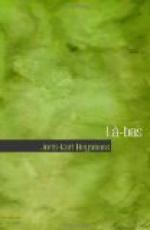Then there was a print of Breughel, engraved by Cock, “The wise and the foolish virgins”: a little panel, cut in the middle by a corkscrew cloud which was flanked at each side by angels with their sleeves rolled up and their cheeks puffed out, sounding the trumpet, while in the middle of the cloud another angel, bizarre and sacerdotal, with his navel indicated beneath his languorously flowing robe, unrolled a banderole on which was written the verse of the Gospel, “Ecce sponsus venit, exite obviam ei.”
Beneath the cloud, at one side, sat the wise virgins, good Flemings, with their lighted lamps, and sang canticles as they turned the spinning wheel. At the other side were the foolish virgins with their empty lamps. Four joyous gossips were holding hands and dancing in a ring on the greensward, while the fifth played the bagpipe and beat time with her foot. Above the cloud the five wise virgins, slender and ethereal now, naked and charming, brandished flaming tapers and mounted toward a Gothic church where Christ stood to welcome them; while on the other side the foolish virgins, imperfectly draped, beat vainly on a closed door with their dead torches.
The blessed naivete of the Primitives, the homely touches in the scenes of earth and of heaven! Durtal loved this old engraving. He saw in it a union of the art of an Ostade purified and that of a Thierry Bouts.
Waiting for his grate, in which the charcoal was crackling and peeling and running like frying grease, to become red, he sat down in front of his desk and ran over his notes.
“Let’s see,” he said to himself, rolling a cigarette, “we had come to the time when that excellent Gilles de Rais begins the quest of the ‘great work.’ It is easy to figure what knowledge he possessed about the method of transmuting metals into gold.
“Alchemy was already highly developed a century before he was born. The writings of Albertus Magnus, Arnaud de Villeneuve, and Raymond Lully were in the hands of the hermetics. The manuscripts of Nicolas Flamel circulated, and there is no doubt that Gilles had acquired them, for he was an avid collector of the rare. Let us add that at that epoch the edict of Charles interdicting spagyric labours under pain of prison and hanging, and the bull, Spondent pariter quas non exhibent, which Pope John XXII fulminated against the alchemists, were still in vigour. These treatises were, then, forbidden, and in consequence desirable. It is certain that Gilles had long studied them, but from that to understanding them is a far cry.
“For they were written in an impossible jargon of allegories, twisted and obscure metaphors, incoherent symbols, ambiguous parables, enigmas, and ciphers. And here is an example.” He took from one of the shelves of the library a manuscript which was none other than the Asch-Mezareph, the book of the Jew Abraham and of Nicolas Flamel, restored, translated, and annotated by Eliphas Levi. This manuscript had been lent him by Des Hermies, who had discovered it one day among some old papers.




